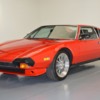MAKE A OFFER !! 24000 Miles
In recent years we have heard much about the rash of corporate takeovers within the business world. In an increasingly competitive global economy, small companies inevitably become the target of larger establishments wishing to increased their market dominance and their balance sheets.
One such area where corporate raiding has indeed become rampant is in the automotive industry. Since 1986, more than a dozen small and mid-sized manufactures have either been taken over by larger concerns or simply forced into dissolution by the increasingly competitive marketplace. Many automakers which continue to produce motorcars under their own marquee have also entered - sometimes unwillingly - into partnerships with larger manufacturers to produce limited production models. For the smaller companies it is a way to utilize the assets and resources of the larger car builders and gain entry into the lucrative high-volume car game. For the Fords and Chrysler's of the world it is a way of producing special lines of automobiles under the names and reputations of a smaller, more prestigious automakers.
Yet, corporate takeovers and partnerships between rival automakers are nothing new. The Ford Motor Company, as many of you will remember, very nearly purchased Ferrari S.p.A during the late 1960s when the Modena automaker became mired in financial difficulties. Although surprised by Mr. Ferrari, Ford nonetheless continued and it search to appropriate a European badge. This search ultimately led to the doorstep of former race driver Alejandro de Tomaso, and the evolution of the De Tomaso Pantera.
While still a young man, Alejandro de Tomaso quickly earned a reputation as a stubborn, intense competitor. After retiring from professional racing in the early 1960s, De Tamaso formed Automobili De Tomaso just outside Modena, Italy and soon became regarded as an autocaratic and somewhat temperamental genius. Ford, for their part, saw the acquisition of De Tomaso as serving several different purposes. Lee Iacocca, then president of Ford, was intent on strengthening the sagging Lincoln-Mercury division. The clearest way to accomplish this was to develop an easy car to sell. Furthermore, there was no mistaking that a sleek two-seater would invariably create some excitement, and it was secretly hoped that this enthusiasm would carry over to the company's other ho-hum models.
Thirdly, included under the De Tomaso banner were two of the most respected Italian coachbuilders - Ghia and Vignale. By purchasing De Tomaso, Ford effectively ranked within the three most respected specially car builders in the world - Pininfarina and Bertone being the other two.
The collaboration actually began with De Tomaso's earlier design, the Mangusta: an aggressive and alluring automobile first seen in prototype form in 1966. While the Mangusta embodied many innovative ideas, the car ultimately suffered from an extremely uncomfortable driving position, a poor gear change and rough handling. When the Pantera debuted at the 1970s New York Show, it was immediately praised as its much improved successor.
On paper the Pantera was an almost perfect venture for Ford. The new car offered a sleek Italian design powered by the reliability and Serviceability of an American "Cleveland" 351 powerplant. Furthermore, the car was to be produced in numbers far exceeding the outputs of the more established European specialty car builders. This high-volume, it was believed, would assure owners of the sizable supply of performance additions and necessary parts available, and servicing the new Pantera could be accomplished at your nearest Lincoln-Mercury dealer.
Regarding the vital statistics of the Pantera, overall length is 167 inches with a wheelbase of only 98.4 inches. The car's unladen weight is 2855 pounds, roughly 600 pounds lighter than the nearest muscle car of its time. Additionally, the De Tomaso has a weight distribution of approximately 60 persent in the rear and 40 percent up front. De Tomaso compensated for this extra weight at the rear and the higher engine power by equipping the car with fat Dunlop 225 VR15s with 31 pounds in front. The combination of bigger rubber and more pressure significantly increased the car's cornering power.
Since styling dictated that the doors should be reasonably even with the windshield post, sliding into the Pantera calls for flexy young body, preferably double-jointed. While the climb into the car is a bit awkward, once inside you feel like a part of the car- locked into the contoured bucket seats with headrests. While one could hardly call the Pantera roomy, there is enough space in the cockpit to accommodate two average sized adults. A six footer has plenty of headroom, his knees won't be aimed into his chin and he can stretch his arms and square his shoulders without feeling like he is in a one-man submarine. This is a nice touch because no such convenience was available in the Mangusta.
Facing the driver is a neat vertical array of gauges; a large cowled tachometer and speedometer and a variety of other instraments. The center console in angled toward the driver and houses a band of rocker switches, instraments, warning lights and heater controls.
We will ship right to your door, Worldwide!
For more information contact Dave at 704-663-0432 or dave@dcclassiccars.com
For Photos and more information visit dcclassiccars.com
Attachments
Original Post


